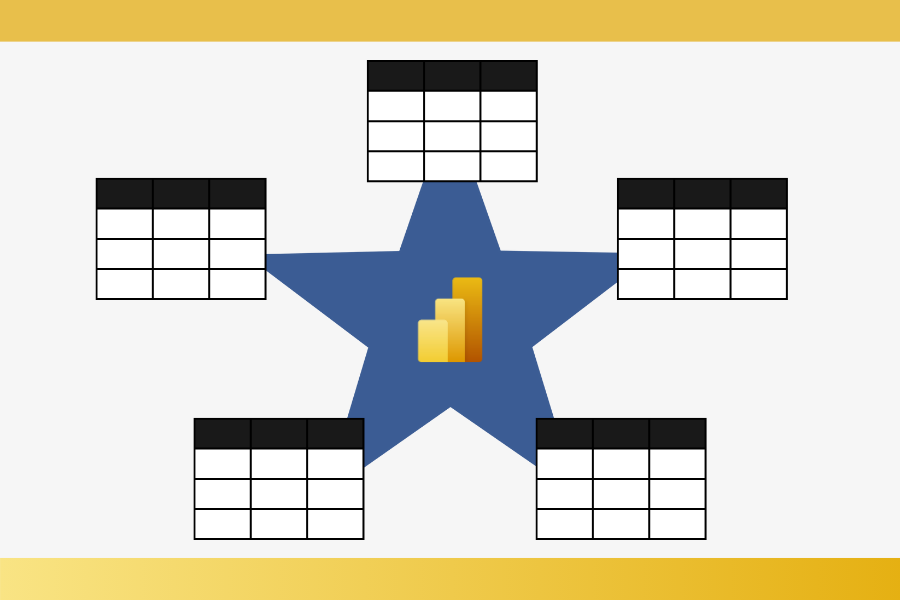What is a star schema?
A star schema is a method of organizing data in which we distinguish two main types of tables:
- fact tables – containing numeric values and measures (e.g. sales, costs, number of orders),
- dimension tables – providing context to the numeric data (e.g. product names, dates, locations, employees).
The model is named after its visual layout—where the fact table sits at the center, and surrounding dimension tables form a shape resembling a star.
In practice, this means that data is organized in a clear and logical way. Each dimension table is directly linked to the fact table, but not to one another. This structure is particularly useful in Business Intelligence systems and data warehouses, as it allows for:
- fast creation of analytical queries,
- simplified reporting logic,
- efficient processing of large data volumes.
The Star schema in Power BI works well in both simple analyses and more complex reporting models. Thanks to its versatility and clarity, it’s a popular choice among analytical teams and business users.
What business benefits does the star schema in Power BI bring?
Implementing the Star schema in Power BI brings several key benefits that directly improve the efficiency and quality of data analysis within an organization. It’s not just a technical solution but a practical tool that supports everyday business decisions.
Faster data analysis
Thanks to a simplified structure where each dimension table directly connects to the fact table, Power BI can process queries and display results much faster. This reduces the number of unnecessary joins and complex relationships, which significantly boosts report performance.
Easy interpretation of results
The star model is easy to understand, even for non-technical users. Business users can easily recognize which data belongs to which table, making it easier to create queries and interpret the metrics presented. This is particularly important in organizations where data analysis is not limited to IT specialists.
Better Power BI performance
The Star schema in Power BI allows for more efficient use of Power BI’s engine, which compresses columnar data better and processes queries faster than normalized relational models. This results in smoother report performance—even with large data sets.
Greater scalability
As organizations grow, so does the volume of both historical and current data. Thanks to its modular and transparent structure, the star schema enables easy model expansion with new dimensions or facts—without the need for a complete system overhaul.
When is it worth using the star schema in Power BI?
While the Star schema in Power BI can be used in nearly every field, it performs particularly well in scenarios that require regular analysis of numeric data across multiple business dimensions. Here are a few typical use cases:
Sales analysis
The star schema works perfectly in Power BI sales reports, where the sales fact table is at the center, and surrounding dimension tables include product, customer, region, or sales channel. This setup enables quick analysis of KPIs, margins, seasonal trends, or team performance.
Finance and controlling
In finance and controlling, the Power BI star model allows for clear comparisons of cost and revenue data across dimensions such as department, project, accounting period, or cost type. It helps manage budgets and optimize spending.
HR and personnel
When analyzing HR data—such as salaries, employee turnover, or absences—the star model lets you combine facts (e.g. number of employees, days absent) with dimensions like department, job title, location, or experience level.
Logistics
The Star schema in Power BI supports warehouse and logistics analysis, such as stock levels or delivery timeliness. Dimension tables may include product information, suppliers, warehouse locations, and delivery times.
Star schema in Power BI – an investment in better analytics
The Star schema in Power BI is one of the most effective approaches to data modeling. With its clear structure and optimized performance, it helps companies analyze data faster, interpret results more easily, and make smarter business decisions. It supports not only data analysts but also managers and business professionals who use reports on a daily basis.
If you want your Power BI reports to run faster, be more intuitive, and scale easily as your data grows—the star schema is a solution worth implementing.
Want to learn how to apply best practices for data modeling in your organization?
Book a free consultation and discover how to build a modern, clear data model.
We’ll help you design an efficient report structure, optimize data processing, and unlock the full potential of Power BI. | CONTACT


